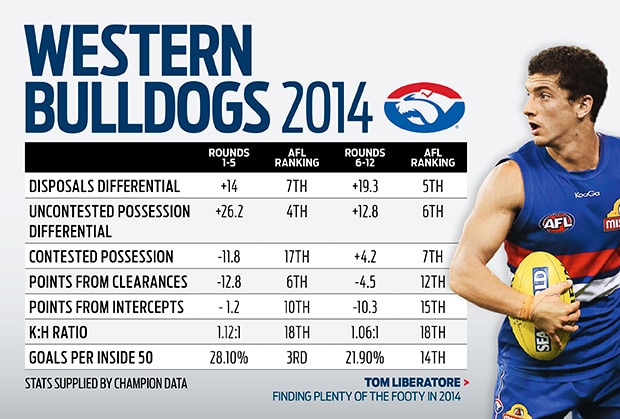RATHER than being irrelevant, the Western Bulldogs simply disappeared all together in the second quarter against the Brisbane Lions on Saturday night.
The Dogs had 10 fewer contested possessions, gained 457 less metres than the Lions and attacked through the corridor just 15 per cent of the time.
Captaincy not a form factor, says Griffen
The team did not launch a score from its defensive 50, with both its goals coming from stoppages. When under pressure, players referred the drama to a teammate with a handball.
The Dogs dropped 33 points behind on the scoreboard to go into half-time trailing by 27 points.
The harsh assessment is that the Dogs didn't take the game on until they was so far behind they had no other choice.
That is what teams struggling for traction do better than most.
The statistic that points to that analysis is that the Bulldogs played on after a mark just 28.6 per cent of the time in the second quarter compared to 85.7 per cent of the time in the last term.
The end of the game was like watching a park cricketer hitting a few lusty blows when the run rate gets above 15 runs an over and there are few wickets left.
Unfortunately, Bulldogs supporters are becoming used to seeing their team outscored by a large amount in one game-busting quarter.
It was the fifth time in five games the team has been outscored by four goals or more in a single quarter this season.
Bulldogs skipper Ryan Griffen calls such moments “lapses” but frustrated fans have an array of words to describe those quarters that are less civil.
Inevitably the repetitive lapses, and recurring explanations that accompany them, have led to impatience with the progress being made.
However, the story leading up to Bulldogs' inconsistency within games this season bears telling.
The position the Bulldogs find themselves in might be disappointing but there are identifiable reasons.
It was one of five clubs that made the top four between 2008 and 2010.
Of the five, only the Bulldogs failed to make a Grand Final and St Kilda just failed to win a flag. Geelong, Hawthorn and Collingwood saluted.
Perhaps that explains, to some extent, why four years later both those 'so near' clubs are in the bottom five of the ladder and Geelong, Hawthorn and Collingwood remain in the top five.
List decisions were made at the time as the club pushed for football's Everest, with Barry Hall and Scott Welsh arriving to bolster the forward line after the Jason Akermanis experiment fizzled.
Investment in development waned in comparison to the Cats, the Hawks and the Magpies, as Brendan McCartney noted on Fairfax Radio on Sunday.
International rookies and long-term project players were not available to a club being financially prudent. The Cats have Mark Blicavs, Collingwood Jarrod Witts and Hawthorn Luke Breust to show for their investment.
And expansion clubs Gold Coast and Greater Western Sydney took young Bulldogs Jarrod Harbrow and Callan Ward as they entered their prime.
The Bulldogs received compensation for those losses but in the snakes and ladders game that AFL list management was during that period, it landed on a snake and slipped back a couple of years.
Adam Cooney suffered a knee injury that limited his output too.
For a club that was renowned for creating turnovers deep in defence and attacking, it struggled to cover the loss of rebounding defenders Lindsay Gilbee, Ryan Hargrave, Brian Lake as well as Harbrow.

New coach McCartney arrived with a promise to build and develop and keep the focus on the team. Using the word 'we' instead of 'I' became something of a mantra of his.
Quality youngsters added to the team since 2010 include Mitch Wallis, Tom Liberatore, Jake Stringer and Jackson Macrae.
Potentials in that time include Nathan Hrovat, Luke Dahlhaus, Marcus Bontempelli, Lachie Hunter and Clay Smith.
And the jury remains out (or in depending on how harsh a judge you are) on Jarrad Grant, Ayce Cordy, Liam Jones, Christian Howard and Jason Tutt.
McCartney has added some players but he may have shown too much patience with key forwards Liam Jones and Grant. However his options have been limited. Stewart Crameri was a big name signing but mostly the club has gone to the draft, as Port Adelaide did when the Bulldogs were playing preliminary finals.
One growing issue is leadership. Having lost almost a generation, the Dogs don’t seem to have a mid-range age of players dragging the others forward.
Griffen admitted as much on Tuesday.
"We've got a young group and it is just dealing with those pressures. When teams come at us it certain guys might go into their shells a little bit and I think we just have to bring that out. As a leadership group those are times we have to step up," Griffen said.
They sure do.
Despite perceptions, the Bulldogs are back winning the contested ball in recent weeks.
The bigger problem since round five is the struggle to turn inside 50s into scores.
The team still turns the ball over deep in defence but those attacking launches are breaking down, reducing opportunities to score. It would like Robert Murphy and Shaun Higgins at both ends but it can't.
Since round five, the Dogs have lost three games by fewer than 10 points.
The statistics, the talent on their books and their recent history suggest the Bulldogs have a story.
It's time to tell it with more urgency.


